weight HONDA RIDGELINE 2014 1.G Owners Manual
[x] Cancel search | Manufacturer: HONDA, Model Year: 2014, Model line: RIDGELINE, Model: HONDA RIDGELINE 2014 1.GPages: 422, PDF Size: 9.32 MB
Page 28 of 422
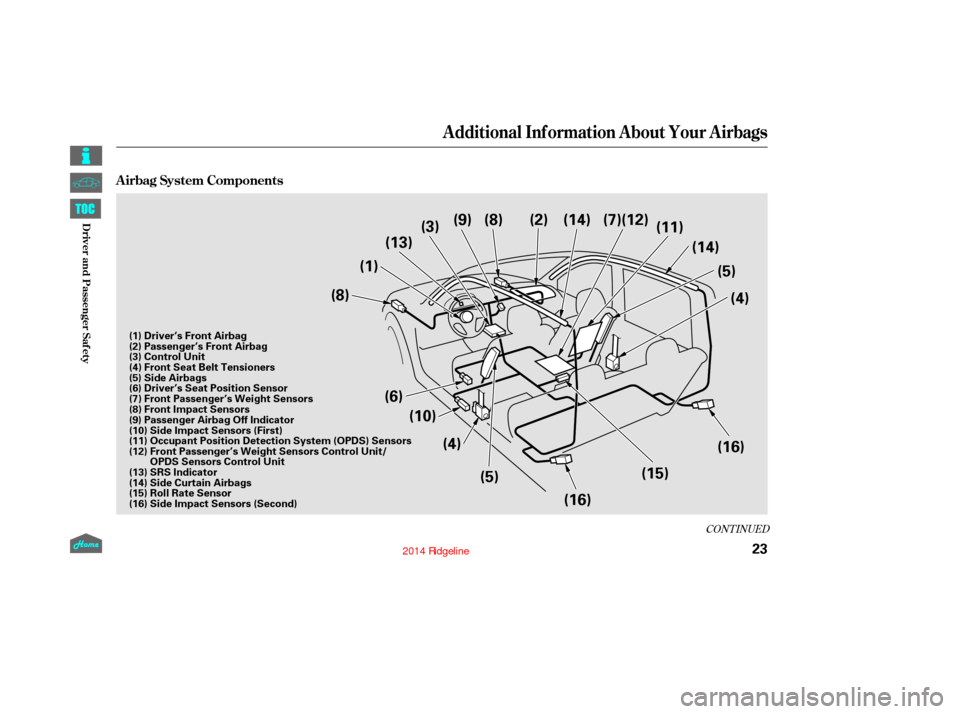
CONT INUED
A irbag System Components
Additional Inf ormation About Your Airbags
23
(1)(3)
(5)
(4) (5)
(6)
(10)
(13)
(9) (8) (2)
(16)(4)
(15)
(16)
(8)
(14) (7)(12)
(14)
(11)
(1) Driver’s Front Airbag
(2) Passenger’s Front Airbag
(3) Control Unit
(4) Front Seat Belt Tensioners
(5) Side Airbags
(6) Driver’s Seat Position Sensor
(7) Front Passenger’s Weight Sensors
(12) Front Passenger’s Weight Sensors Control Unit/
OPDS Sensors Control Unit
(13) SRS Indicator
(14) Side Curtain Airbags
(15) Roll Rate Sensor
(16) Side Impact Sensors (Second) (8) Front Impact Sensors
(9) Passenger Airbag Off Indicator
(10) Side Impact Sensors (First)
(11) Occupant Position Detection System (OPDS) Sensors
12/08/09 16:02:03 31SJC670_030
Driver and Passenger Saf ety
Page 29 of 422
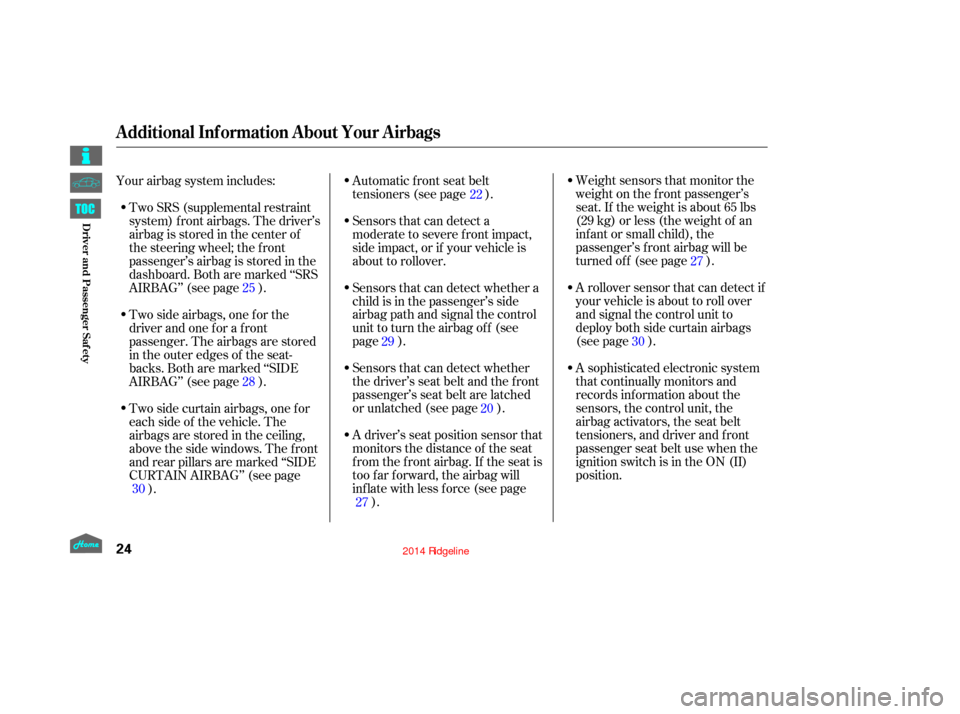
Weight sensors that monitor the
weight on the f ront passenger’s
seat. If the weight is about 65 lbs
(29 kg) or less (the weight of an
inf ant or small child), the
passenger’s f ront airbag will be
turned of f (see page ).
A rollover sensor that can detect if
your vehicle is about to roll over
and signal the control unit to
deploy both side curtain airbags
(see page ).
A sophisticated electronic system
that continually monitors and
records inf ormation about the
sensors, the control unit, the
airbag activators, the seat belt
tensioners, and driver and f ront
passenger seat belt use when the
ignition switch is in the ON (II)
position.
Automatic front seat belt
tensioners (see page ).
Sensors that can detect a
moderate to severe front impact,
side impact, or if your vehicle is
about to rollover.
Sensors that can detect whether a
child is in the passenger’s side
airbag path and signal the control
unit to turn the airbag of f (see
page ).
Sensors that can detect whether
the driver’s seat belt and the f ront
passenger’s seat belt are latched
or unlatched (see page ).
A driver’s seat position sensor that
monitors the distance of the seat
from the front airbag. If the seat is
too f ar f orward, the airbag will
inf late with less f orce (see page
).
Your airbag system includes:
Two SRS (supplemental restraint
system) f ront airbags. The driver’s
airbag is stored in the center of
the steering wheel; the f ront
passenger’sairbagisstoredinthe
dashboard. Both are marked ‘‘SRS
AIRBAG’’ (see page ).
Two side airbags, one f or the
driver and one f or a f ront
passenger. The airbags are stored
in the outer edges of the seat-
backs. Both are marked ‘‘SIDE
AIRBAG’’ (see page ).
Two side curtain airbags, one f or
each side of the vehicle. The
airbags are stored in the ceiling,
above the side windows. The f ront
and rear pillars are marked ‘‘SIDE
CURTAIN AIRBAG’’ (see page ). 27
30
27 20
29
25
28
30 22
Additional Inf ormation About Your Airbags
24
12/08/09 16:02:13 31SJC670_031
Driver and Passenger Saf ety
Page 32 of 422
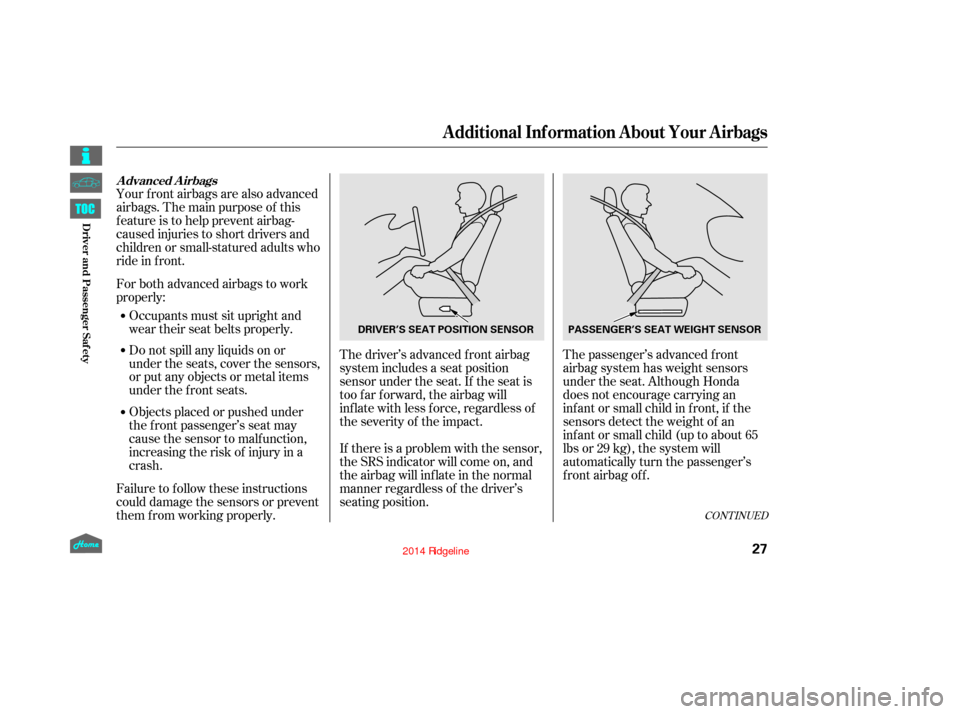
CONT INUED
Your f ront airbags are also advanced
airbags. The main purpose of this
feature is to help prevent airbag-
caused injuries to short drivers and
children or small-statured adults who
ride in f ront.The driver’s advanced front airbag
system includes a seat position
sensor under the seat. If the seat is
too f ar f orward, the airbag will
inf late with less f orce, regardless of
the severity of the impact.The passenger’s advanced f ront
airbag system has weight sensors
under the seat. Although Honda
does not encourage carrying an
inf ant or small child in f ront, if the
sensors detect the weight of an
inf ant or small child (up to about 65
lbs or 29 kg), the system will
automatically turn the passenger’s
front airbag off.
If there is a problem with the sensor,
the SRS indicator will come on, and
the airbag will inf late in the normal
manner regardless of the driver’s
seating position.
Failure to f ollow these instructions
could damage the sensors or prevent
them f rom working properly. For both advanced airbags to work
properly:
Occupants must sit upright and
wear their seat belts properly.
Do not spill any liquids on or
under the seats, cover the sensors,
or put any objects or metal items
under the f ront seats.
Objects placed or pushed under
the f ront passenger’s seat may
cause the sensor to malf unction,
increasing the risk of injury in a
crash.
Additional Inf ormation About Your Airbags
Advanced Airbags
27
DRIVER’S SEAT POSITION SENSOR PASSENGER’S SEAT WEIGHT SENSOR
12/08/09 16:02:37 31SJC670_034
Driver and Passenger Saf ety
Page 33 of 422
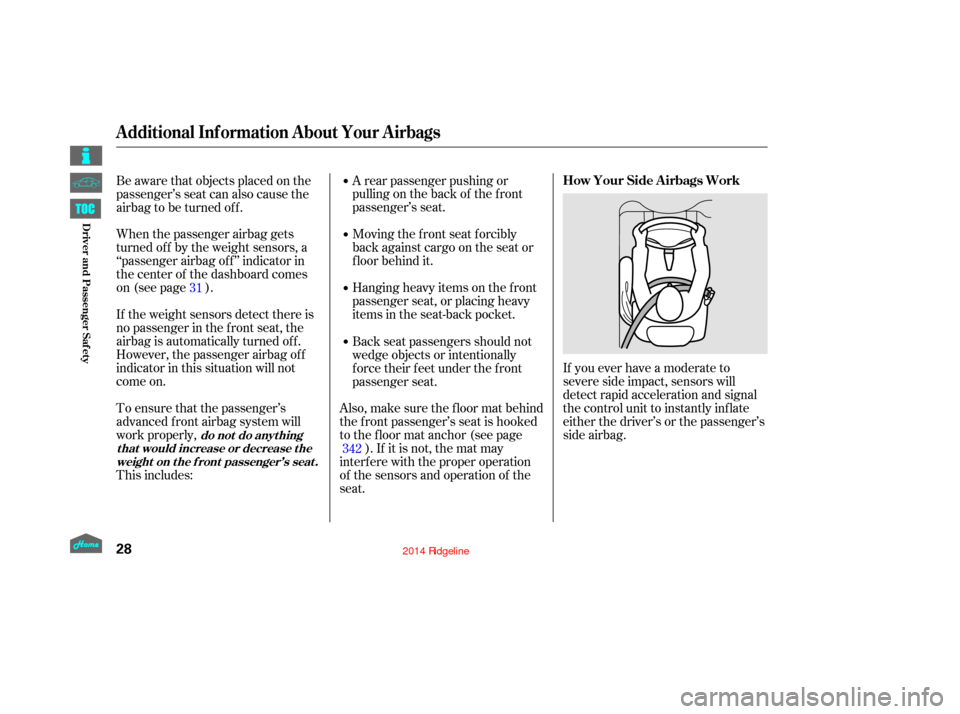
Hanging heavy items on the f ront
passenger seat, or placing heavy
items in the seat-back pocket. Moving the f ront seat f orcibly
back against cargo on the seat or
f loor behind it. A rear passenger pushing or
pulling on the back of the f ront
passenger’s seat.
When the passenger airbag gets
turned of f by the weight sensors, a
‘‘passenger airbag of f ’’ indicator in
the center of the dashboard comes
on (see page ). Be aware that objects placed on the
passenger’s seat can also cause the
airbag to be turned off.
If you ever have a moderate to
severe side impact, sensors will
detect rapid acceleration and signal
the control unit to instantly inf late
either the driver’s or the passenger’s
side airbag.
To ensure that the passenger’s
advanced front airbag system will
work properly,
This includes: If the weight sensors detect there is
no passenger in the f ront seat, the
airbag is automatically turned off.
However, the passenger airbag of f
indicator in this situation will not
come on.
Also,makesurethefloormatbehind
the f ront passenger’s seat is hooked
to the floor mat anchor (see page). If it is not, the mat may
interf ere with the proper operation
of the sensors and operation of the
seat. Back seat passengers should not
wedge objects or intentionally
f orce their f eet under the f ront
passenger seat.
31
342
Additional Inf ormation About Your Airbags
How Your Side A irbags Work
do not do anyt hing
t hat would increase or decrease t he weight on the f ront passenger’s seat.
28
12/08/09 16:02:46 31SJC670_035
Driver and Passenger Saf ety
Page 36 of 422
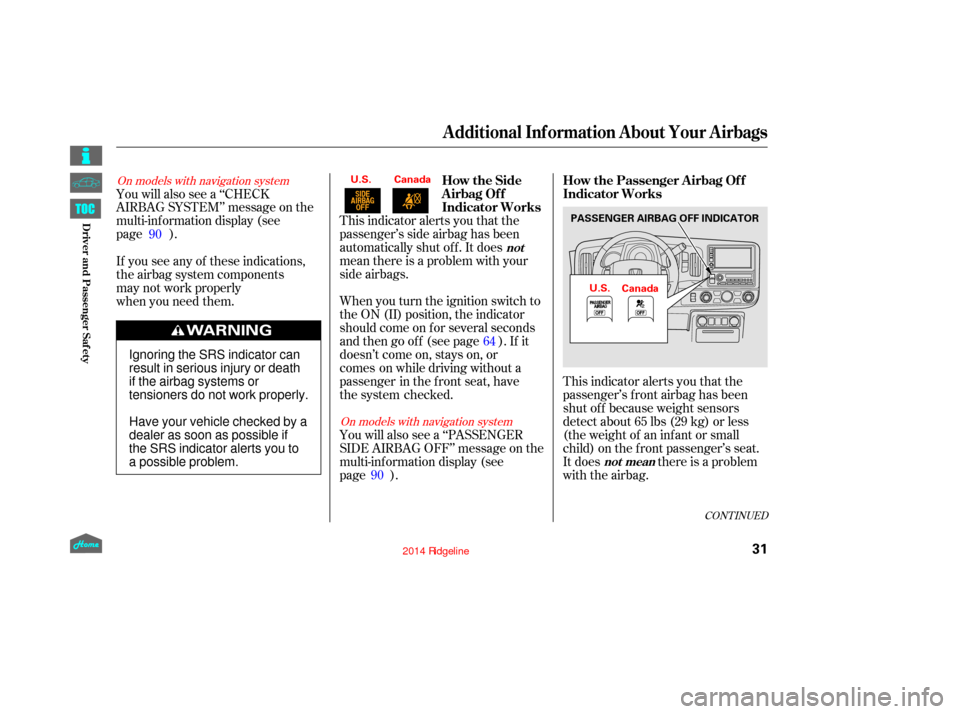
CONT INUED
This indicator alerts you that the
passenger’s f ront airbag has been
shut of f because weight sensors
detect about 65 lbs (29 kg) or less
(the weight of an inf ant or small
child) on the f ront passenger’s seat.
It does there is a problem
with the airbag.
You will also see a ‘‘CHECK
AIRBAG SYSTEM’’ message on the
multi-information display (see
page
). This indicator alerts you that the
passenger’s side airbag has been
automatically shut off. It does
mean there is a problem with your
side airbags.
When you turn the ignition switch to
the ON (II) position, the indicator
should come on for several seconds
and then go off (see page ). If it
doesn’t come on, stays on, or
comes on while driving without a
passenger in the front seat, have
the system checked.
You will also see a ‘‘PASSENGER
SIDE AIRBAG OFF’’ message on the
multi-information display (see
page
).
If you see any of these indications,
the airbag system components
may not work properly
when you need them.
90
9064
On models with navigation system
On models with navigation system
Additional Inf ormation About Your Airbags
How the Passenger Airbag Of f
Indicator Works
How the Side
Airbag Of f
Indicator Works
not mean
not
31
Canada
PASSENGER AIRBAG OFF INDICATOR
U.S.
U.S. Canada
Ignoring the SRS indicator can
result in serious injury or death
if the airbag systems or
tensioners do not work properly.
Have your vehicle checked by a
dealer as soon as possible if
the SRS indicator alerts you to
a possible problem.
12/08/09 16:03:13 31SJC670_038
Driver and Passenger Saf ety
Page 37 of 422
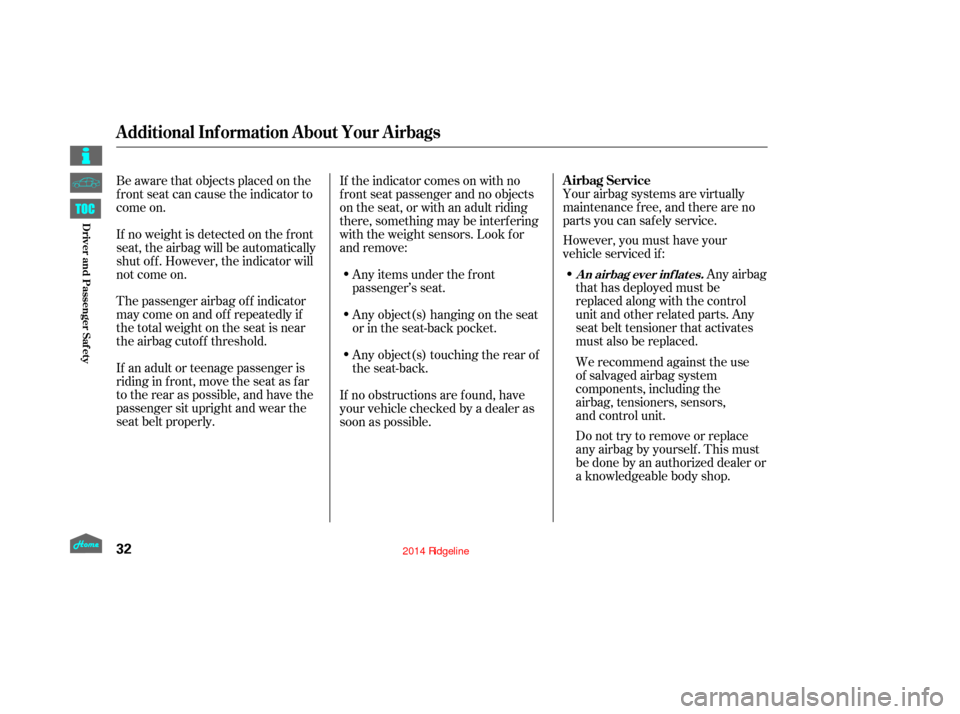
Your airbag systems are virtually
maintenance f ree, and there are no
parts you can saf ely service.
However, you must have your
vehicle serviced if:Any airbag
that has deployed must be
replaced along with the control
unit and other related parts. Any
seat belt tensioner that activates
must also be replaced.
Be aware that objects placed on the
f ront seat can cause the indicator to
come on.
If no weight is detected on the f ront
seat, the airbag will be automatically
shut of f . However, the indicator will
not come on.
The passenger airbag of f indicator
maycomeonandoff repeatedlyif
the total weight on the seat is near
the airbag cutof f threshold.
If an adult or teenage passenger is
riding in f ront, move the seat as f ar
to the rear as possible, and have the
passenger sit upright and wear the
seat belt properly. If the indicator comes on with no
f ront seat passenger and no objects
on the seat, or with an adult riding
there, something may be interf ering
with the weight sensors. Look f or
and remove:
Any items under the f ront
passenger’s seat.
Any object(s) touching the rear of
the seat-back.
If no obstructions are f ound, have
your vehicle checked by a dealer as
soon as possible. Any object(s) hanging on the seat
or in the seat-back pocket.
We recommend against the use
of salvaged airbag system
components, including the
airbag, tensioners, sensors,
and control unit.
Do not try to remove or replace
anyairbagbyyourself.Thismust
be done by an authorized dealer or
a knowledgeable body shop.
Additional Inf ormation About Your Airbags
Airbag Service
An airbag ever inf lates.
32
12/08/09 16:03:23 31SJC670_039
Driver and Passenger Saf ety
Page 38 of 422
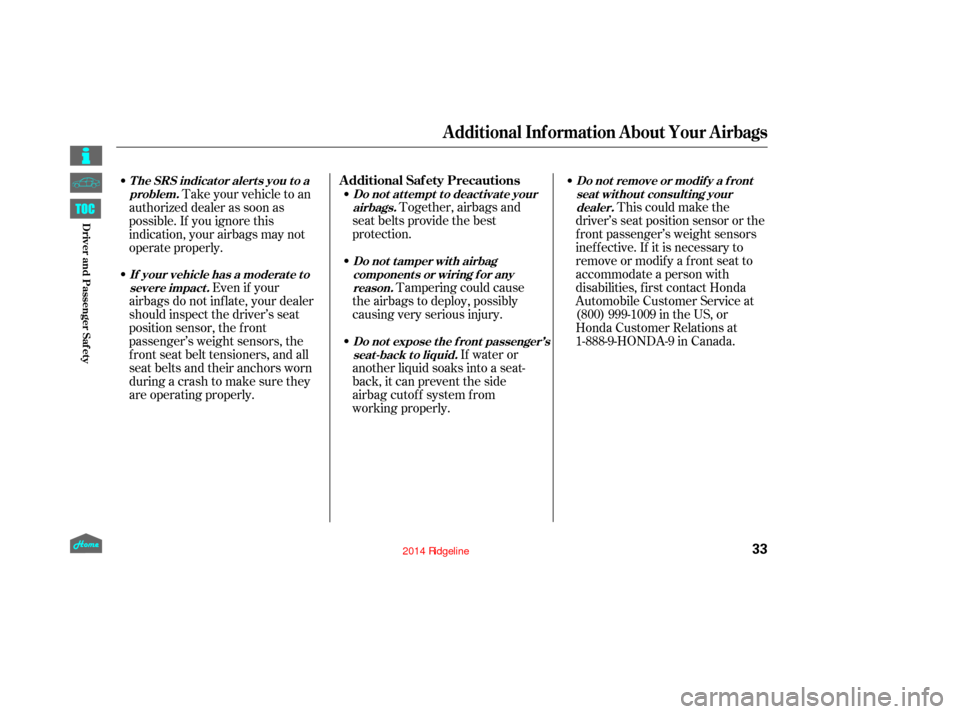
Together, airbags and
seat belts provide the best
protection.
Tampering could cause
the airbags to deploy, possibly
causing very serious injury.
If water or
another liquid soaks into a seat-
back, it can prevent the side
airbag cutoff system from
working properly. This could make the
driver’s seat position sensor or the
f ront passenger’s weight sensors
inef f ective. If it is necessary to
remove or modif y a f ront seat to
accommodate a person with
disabilities, f irst contact Honda
Automobile Customer Service at
(800) 999-1009 in the US, or
Honda Customer Relations at
Even if your
airbags do not inflate, your dealer
should inspect the driver’s seat
position sensor, the f ront
passenger’s weight sensors, the
f ront seat belt tensioners, and all
seat belts and their anchors worn
during a crash to make sure they
are operating properly. Take your vehicle to an
authorized dealer as soon as
possible. If you ignore this
indication, your airbags may not
operate properly.
Additional Inf ormation About Your Airbags
Additional Saf ety Precautions
Donotattempttodeactivateyour
airbags.
Do not t amper wit h airbagcomponent s or wiring f or anyreason.
Do not expose the f ront passenger’sseat-back to liquid. Do not remove or modif y a f ront
seat without consulting yourdealer.
If your vehicle has a moderat e t o severe impact .
T he SRS indicat or alert s you t o a
problem.
33
12/08/09 16:03:29 31SJC670_040
Driver and Passenger Saf ety
1-888-9-HONDA-9 in Canada.
Page 44 of 422
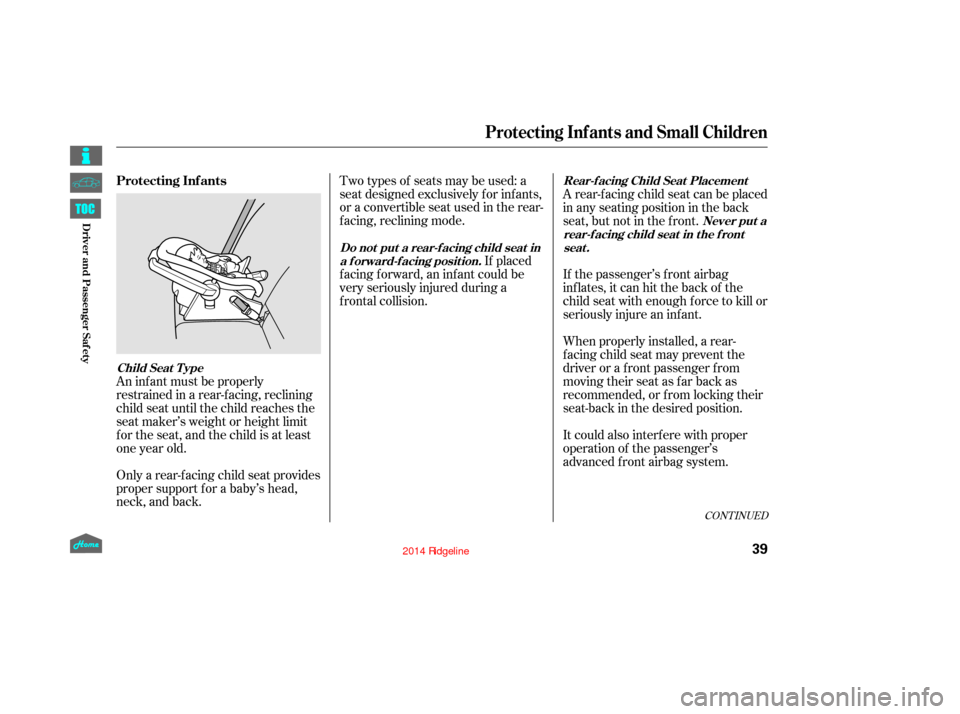
CONT INUED
An inf ant must be properly
restrained in a rear-f acing, reclining
child seat until the child reaches the
seat maker’s weight or height limit
f or the seat, and the child is at least
one year old.
Only a rear-f acing child seat provides
proper support f or a baby’s head,
neck, and back.Two types of seats may be used: a
seat designed exclusively f or inf ants,
or a convertible seat used in the rear-
f acing, reclining mode.
If placed
f acing f orward, an inf ant could be
very seriously injured during a
f rontal collision. A rear-f acing child seat can be placed
in any seating position in the back
seat, but not in the f ront.
If the passenger’s front airbag
inflates, it can hit the back of the
child seat with enough f orce to kill or
seriously injure an inf ant.
When properly installed, a rear-
f acing child seat may prevent the
driver or a f ront passenger f rom
moving their seat as far back as
recommended, or f rom locking their
seat-back in the desired position.
It could also interf ere with proper
operation of the passenger’s
advanced front airbag system.
Protecting Inf ants
Child Seat T ype
Do not put a rear-f acing child seat in
a f orward-f acing position. Never put a
rear-f acing child seat in t he f ront seat .
Rear-f acing Child Seat Placement
Protecting Inf ants and Small Children
39
12/08/09 16:04:21 31SJC670_046
Driver and Passenger Saf ety
Page 45 of 422
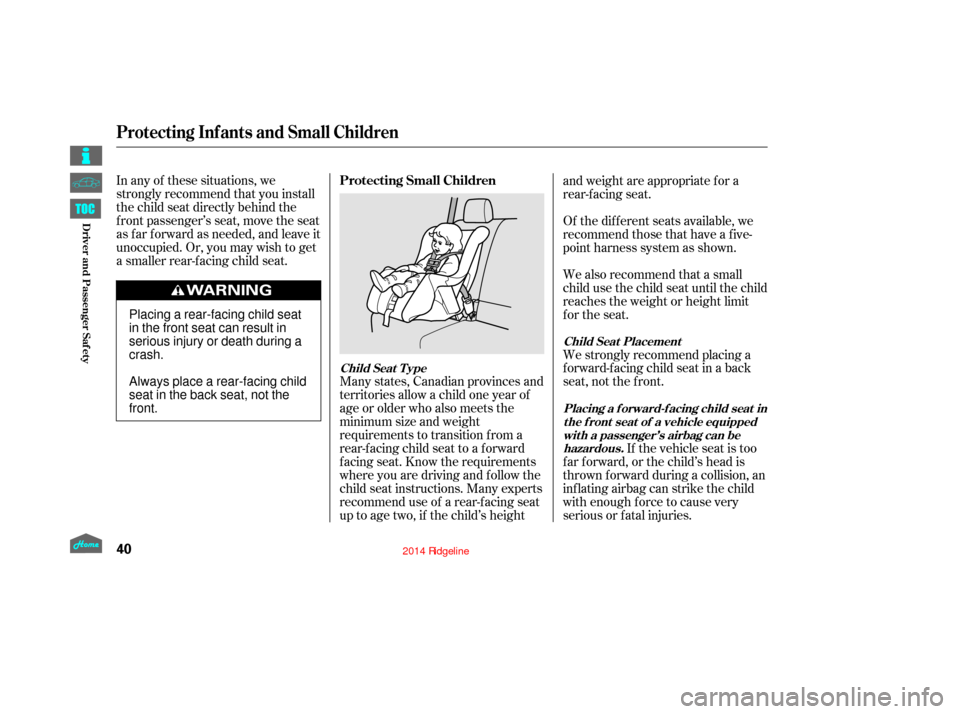
In any of these situations, we
strongly recommend that you install
the child seat directly behind the
f ront passenger’s seat, move the seat
as far forward as needed, and leave it
unoccupied. Or, you may wish to get
a smaller rear-f acing child seat.Many states, Canadian provinces and
territories allow a child one year of
age or older who also meets the
minimum size and weight
requirements to transition f rom a
rear-facing child seat to a forward
f acing seat. Know the requirements
where you are driving and follow the
child seat instructions. Many experts
recommend use of a rear-f acing seat
up to age two, if the child’s heightand weight are appropriate f or a
rear-facing seat.
If the vehicle seat is too
f ar f orward, or the child’s head is
thrown f orward during a collision, an
inf lating airbag can strike the child
with enough force to cause very
serious or fatal injuries. We strongly recommend placing a
forward-facing child seat in a back
seat, not the f ront. We also recommend that a small
child use the child seat until the child
reaches the weight or height limit
for the seat. Of the different seats available, we
recommend those that have a f ive-
point harness system as shown.
Protecting Inf ants and Small Children
Protecting Small Children
Child Seat T ype
Placing a f orward-f acing child seat inthe f ront seat of a vehicle equippedwith a passenger’s airbag can behazardous.
Child Seat Placement
40
Placing a rear-facing child seat
in the front seat can result in
serious injury or death during a
crash.
Always place a rear-facing child
seat in the back seat, not the
front.
12/08/09 16:04:30 31SJC670_047
Driver and Passenger Saf ety
Page 46 of 422
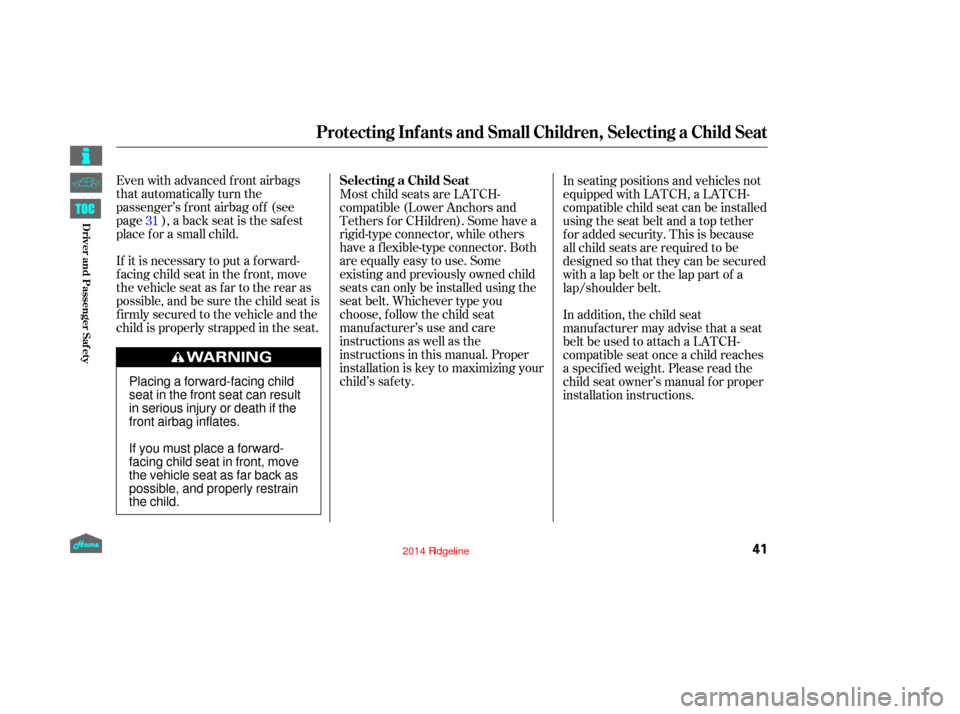
If it is necessary to put a f orward-
f acing child seat in the f ront, move
the vehicle seat as far to the rear as
possible, and be sure the child seat is
f irmly secured to the vehicle and the
child is properly strapped in the seat. Even with advanced front airbags
that automatically turn the
passenger’s front airbag off (see
page ), a back seat is the saf est
place f or a small child.Most child seats are LATCH-
compatible (Lower Anchors and
Tethers f or CHildren). Some have a
rigid-type connector, while others
have a f lexible-type connector. Both
are equally easy to use. Some
existing and previously owned child
seats can only be installed using the
seat belt. Whichever type you
choose, f ollow the child seat
manufacturer’s use and care
instructions as well as the
instructions in this manual. Proper
installation is key to maximizing your
child’s saf ety.In seating positions and vehicles not
equipped with LATCH, a LATCH-
compatible child seat can be installed
using the seat belt and a top tether
f or added security. This is because
all child seats are required to be
designed so that they can be secured
with a lap belt or the lap part of a
lap/shoulder belt.
In addition, the child seat
manufacturer may advise that a seat
belt be used to attach a LATCH-
compatible seat once a child reaches
a specif ied weight. Please read the
child seat owner’s manual f or proper
installation instructions.
31
Protecting Inf ants and Small Children, Selecting a Child Seat
Selecting a Child Seat
41
Placing a forward-facing child
seat in the front seat can result
in serious injury or death if the
front airbag inflates.
Ifyoumustplaceaforward-
facing child seat in front, move
the vehicle seat as far back as
possible, and properly restrain
the child.
12/08/09 16:04:36 31SJC670_048
Driver and Passenger Saf ety